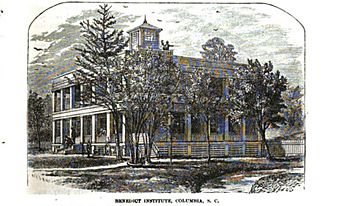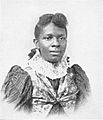Benedict College facts for kids
 |
|
|
Former names
|
Benedict Institute (1870–1894) |
|---|---|
| Motto | A Power for Good in Society |
| Type | Private historically black college |
| Established | December 12, 1870 |
|
Religious affiliation
|
American Baptist Churches USA |
| Endowment | $21.7 million (2024) |
| President | Roslyn Clark Artis |
| Students | 1,731 (fall 2023) |
| Location |
,
South Carolina
,
United States
|
| Campus | 110-acre (45 ha) |
| Colors | Purple and gold |
| Nickname | Tigers |
|
Sporting affiliations
|
NCAA Division II - SIAC |
|
Benedict College Historic District
|
|

original Benedict College building as seen in 1875
|
|
| Lua error in Module:Location_map at line 420: attempt to index field 'wikibase' (a nil value). | |
| Location | Roughly bounded by Laurel, Oak, Taylor and Harden Sts. on Benedict College campus, Columbia, South Carolina |
| Area | 3.9 acres (1.6 ha) |
| Architect | Urquhart, James B. |
| Architectural style | Classical Revival |
| NRHP reference No. | 87000809 |
| Added to NRHP | April 20, 1987 |
Benedict College is a private college in Columbia, South Carolina, USA. It is known as a historically black college (HBCU). This means it was founded to provide education for African Americans.
The college was started in 1870 by a group of Baptists from the northern United States. It began as a school to train teachers. Over time, it grew to offer many different subjects in the liberal arts. The campus also includes special buildings that are part of the Benedict College Historic District. This area is listed on the National Register of Historic Places because of its important history.
Benedict College was built on a large piece of land that used to be a plantation. This land is about 110 acres. A woman named Bathsheba A. Benedict from Rhode Island gave money to buy the land. Many schools like Benedict College were started in the South after the Civil War. They helped formerly enslaved people get an education, which was very important for their future.
Contents
The College's History
Benedict Institute first opened its doors on December 12, 1870.
The first class at Benedict had ten students. These students were formerly enslaved people. Their teacher and the first president of the school was Reverend Timothy Dodge. He was a college-educated preacher from the North. Classes were first held in the main house of the old plantation.
The main goal of the institute was to help men and women become "powers for good in society." Since enslaved people were not allowed to learn to read or write, the first classes taught basic reading, writing, and math. They also studied the Bible and theology. Later, more subjects were added to help train teachers and preachers, which was the school's original purpose.
On November 2, 1894, the school officially became a four-year college. The South Carolina government gave it a special charter, and its name changed to Benedict College. Besides money from Baptist supporters, the school also received grants from the Slater Fund.
From 1870 to 1930, seven different white Baptist ministers led Benedict College. All of them had gone to college. On April 10, 1930, Reverend John J. Starks became the first African-American president of the college. He had graduated from Benedict College in 1891. Since then, five more African-American presidents have led the college.
Growth and Campus Improvements
In 1994, Benedict College made a plan to have 2,000 students by the year 2000. They reached this goal even earlier, in 1996, with 2,138 students. By the fall of 2002, the number of students grew to 3,000. Benedict College continues to plan for its future growth and success.
The college has been working on a big plan to improve its campus. This plan includes buying more land and building a large sports complex. Over the past several years, many improvements have been made to the campus buildings. Student dorms have been updated with air conditioning, fire safety systems, and security. An activities field and community park were completed. Historic buildings like Antisdel Chapel, Bacoats Hall, and Alumni Hall have been renovated. Morgan, Pratt, and Starks halls have also been restored.
New buildings have been constructed, including three student dorms, a parking garage, a dining hall, and an Administration Building. The college also bought buildings for a fitness center and a community development center. Three apartment complexes were bought to provide more housing for students. As part of its goal to help the community, Benedict College has also fixed up more than 50 old properties in the area around the campus.
Benedict College Historic District
The Benedict College Historic District was added to the National Register of Historic Places in 1987. This district includes five important buildings built between 1895 and 1937. These buildings are Morgan Hall (1895), Pratt Hall (1902), Duckett Hall (1925), Antisdel Chapel (1932), and Starks Center (1937).
Academics and Learning
Benedict College offers 29 different degrees. These degrees are taught by 12 different departments.
Besides traditional college programs, the college also offers classes for "non-traditional students." These are people who might be older or have different schedules.
Accreditation and Quality
Benedict College is officially approved by the Commission on Colleges of the Southern Association of Colleges and Schools. This means the college meets high standards for education and can give out bachelor's degrees.
The Teacher Education Program is approved by the South Carolina Department of Education. The Social Work Program is approved by the Council on Social Work Education. The Environmental Health Science Program is also approved by a national council.
Marching Tigers "Band of Distinction"
Benedict's Marching Tigers "Band of Distinction" started in the 1960s. The band plays at most football games, home basketball games, and other special events. Mr. Herman Jones was known for giving the band its special sound. The band is currently led by Henry Wade Johnson. In 2022, the band marched in the famous Macy's Thanksgiving Day Parade.
Benedict College Concert Choir
The Benedict College choir performs in spirituals, festivals, and an annual Christmas concert. Linda Kersaw, a former leader of the choir, led the group for over 20 years. She is one of five people from the Richland One school district to be honored in their Hall of Fame.
Athletics and Sports
Benedict College sports teams are called the Tigers. The college is part of the NCAA Division II (National Collegiate Athletic Association). They mainly compete in the Southern Intercollegiate Athletic Conference (SIAC). They have been part of the SIAC since the 1932–33 school year.
Benedict has 14 different sports teams. Men's sports include baseball, basketball, cross country, football, tennis, track & field, and volleyball. Women's sports include basketball, cheerleading, cross country, softball, tennis, track & field, and volleyball.
Sports Facilities
The college built the Charlie W. Johnson Stadium for its football games on campus. This stadium opened in 2006. Basketball games are played at the HRC Arena.
Team Achievements
The Benedict Tigers tennis team won the SIAC conference championship in 2015.
In 2022, the Tigers football team had their best season ever. They won the SIAC championship. They also qualified for the NCAA Division II playoffs for the first time. In addition, Benedict won the Black college football national championship for schools that compete below the NCAA Division I level.
Benedict College Presidents
- Timothy Dodge
- Lewis Colby
- E. J. Goodspeed
- Charles E. Becker
- Abraham C. Osborn
- Byron W. Valentine
- Clarence B. Antisdel
- John J. Starks
- John A. Bacoats
- Benjamin F. Payton
- Henry Ponder
- Marshall C. Grigsby
- David Swinton
- Roslyn Artis
Notable Alumni
| Name | Class year | Notability | |
|---|---|---|---|
| Chino Smith | Negro league baseball player who had a career batting average of .428 in six seasons. | ||
| Modjeska Monteith Simkins | 1921 | A leader in public health reform and the civil rights movement in South Carolina. | |
| Harold A. Stevens | 1930 | A lawyer and former judge who served on important courts in New York. | |
| Jack B. Johnson | 1970 | Former County Executive for Prince George's County, Maryland. | |
| LeRoy T. Walker | Former Chairman of the U.S. Olympic Committee. | ||
| Waliyy Dixon | A professional streetball player. | ||
| Kris Bruton | A basketball player who played with the Harlem Globetrotters. | ||
| Paul Benjamin | A television and film actor. | ||
| Bennie Lewis | 2009 | A professional basketball player. | |
| Annie Greene Nelson | The first African American woman to publish a novel in South Carolina. | ||
| James Maxie Ponder | The first African American doctor in St. Petersburg, Florida. | ||
| Charles L. Purce | 1879 | President of Selma University and Simmons College of Kentucky. | |
| Mary Rice Phelps | 1885 | A teacher and writer. | |
| Sanco Rembert | 1945 | An Anglican bishop and the first black bishop in the Reformed Episcopal Church. | |
| Walt Simon | 1961 | A professional basketball player and Senior VP at Kentucky Fried Chicken. |
Images for kids




